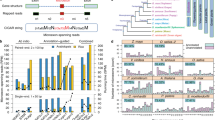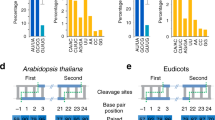A gene-regulation mechanism in plants predates the emergence of flowering species.
Abstract
MicroRNAs are an abundant class of small RNAs that are thought to regulate the expression of protein-coding genes in plants and animals. Here we show that the target sequence of two microRNAs, known to regulate genes in the class-III homeodomain-leucine zipper (HD–Zip) gene family of the flowering plant Arabidopsis, is conserved in homologous sequences from all lineages of land plants, including bryophytes, lycopods, ferns and seed plants. We also find that the messenger RNAs from these genes are cleaved within the same microRNA-binding site in representatives of each land-plant group, as they are in Arabidopsis. Our results indicate not only that microRNAs mediate gene regulation in non-flowering as well as flowering plants, but also that the regulation of this class of plant genes dates back more than 400 million years.
This is a preview of subscription content, access via your institution
Access options
Subscribe to this journal
Receive 51 print issues and online access
$199.00 per year
only $3.90 per issue
Buy this article
- Purchase on Springer Link
- Instant access to full article PDF
Prices may be subject to local taxes which are calculated during checkout

Similar content being viewed by others
References
Talbert, P. B., Adler, H. T., Parks, D. W. & Comai, L. Development 121, 2723–2735 (1995).
McConnell, J. R. & Barton, M. K. Development 125, 2935–2942 (1998).
McConnell, J. R. et al. Nature 411, 709–713 (2001).
Baima, S. et al. Development 121, 4171–4182 (1995).
Emery, J. F. et al. Curr. Biol. 13, 1768–1774 (2003).
Rhoades, M. W. et al. Cell 110, 513–520 (2002).
Reinhart, B. J., Weinstein, E. G., Rhoades, M. W., Bartel, B. & Bartel, D. P. Genes Dev. 16, 1616–1626 (2002).
Tang, G., Reinhart, B. J., Bartel, D. P. & Zamore, P. D. Genes Dev. 17, 49–63 (2002).
Llave, C., Xie, Z., Kasschau, K. D. & Carrington, J. C. Science 297, 2053–2056 (2002).
Aukerman, M. J. & Sakai, H. Plant Cell 15, 2730–2741 (2003).
Zuker, M. Nucleic Acids Res. 31, 3406–3415 (2003).
Pasquinelli, A. E. et al. Nature 408, 86–89 (2000).
Author information
Authors and Affiliations
Corresponding author
Ethics declarations
Competing interests
The authors declare no competing financial interests.
Supplementary information
Supplementary Figure 1
miRNA mediated cleavage of class III HD-ZIP genes in land plants. (DOC 22 kb)
Rights and permissions
About this article
Cite this article
Floyd, S., Bowman, J. Ancient microRNA target sequences in plants. Nature 428, 485–486 (2004). https://doi.org/10.1038/428485a
Published:
Issue Date:
DOI: https://doi.org/10.1038/428485a
This article is cited by
-
Genome-wide identification of Sclerotinia sclerotiorum small RNAs and their endogenous targets
BMC Genomics (2023)
-
Conserved and non-conserved RNA–target modules in plants: lessons for a better understanding of Marchantia development
Plant Molecular Biology (2023)
-
MiRNA fine tuning for crop improvement: using advance computational models and biotechnological tools
Molecular Biology Reports (2022)
-
Integrated miRNA, target mRNA, and metabolome profiling of Tinospora cordifolia with reference to berberine biosynthesis
3 Biotech (2022)
-
Transcriptional control of Arabidopsis seed development
Planta (2022)
Comments
By submitting a comment you agree to abide by our Terms and Community Guidelines. If you find something abusive or that does not comply with our terms or guidelines please flag it as inappropriate.



